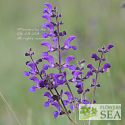(Elk Dwarf Balkan Sage) Violet-blue whorls of flowers and plentiful, fuzzy, basal leaves that reach an impressive length of 18 inches are two notable features about this hardy, herbaceous perennial, which is native to western Asia. This is an extremely compact variety with dark green leaves, quite different in appearance compared with the common species.
Balkan Sage is found in coniferous forests, meadows and slopes from Bulgaria to Turkey's Black Sea coast. However, it is named after the 19th century Finnish plant collector Peter Forsskål, who collected botanical samples further south in Saudi Arabia. This select variety was developed here in our nursery.
Although deciduous in areas with cold winters, it blooms about nine months a year for us on the Northern California coast beginning in summer. Following a brief winter dormancy, it returns reliably every spring, clumping in a way that makes it look like Hosta from a distance. It is a fine choice for a lightly shaded garden or border and is happy in the acid soil under conifers.
Give it soil with average fertility, occasional water and enough shade to promote lush growth. Your reward will be large deep purple flowers with lovely white and yellow bee lines attractive to hummingbirds and honeybees.





